Each year, many US importers purchase products from China, a large manufacturing market. When you buy high-quality products at competitive prices here, you have to pay import duty from China to the USA. Sometimes it can be a huge sum of money. As an importer, you will be very concerned about it and want to estimate it before starting your business.
After reading this article, you’ll be able to know what import taxes you need to pay, and how to calculate them on your own. It will be easier for you to measure the real impact of import duties on your business and make the right decision.
According to our experience, for small and medium-sized businesses, if you are not purchasing containers of goods at one time, the impact of increased tariffs may not be as big as you might think. Now let’s dive into the below article to have a reality check.
- What Import Tax Do You Need to Pay for Imports from China?
- What Is the Additional Customs Duty Rate for Chinese imports?
- What’s HS Code & HTS Code? How to Check It?
- How to Check Import Duty Rate Online by Using HTS Code?
- How to Check If Your Product Is Hit with Additional Duty Rate?
- How Much are Customs Duties & Tax? (Calculation Examples)
- How to pay the import tax? When Is a Customs Bond Required?
- What Are the Common Ways to Avoid or Reduce the Import Tax?
- What Import Duty Calculators can help you simplify the Calculation?
- Q&As about Import Duties from China to the USA.
What Import Tax Do You Need to Pay for Imports from China to the USA?
When imported goods are entering the United States, the US Customs and Border Protection (CBP) will charge some fees on them, whether it is an informal entry or a formal entry.
- Informal entry is an entry of goods valued less than $2, 500, usually imported for personal or commercial use. Some products are restricted from informal entry regardless of value, like high-risk products.
- Formal entry is an entry of goods valued at $2, 500 or more, usually imported for commercial purposes.
Import duty
Import duties or customs duties are the major part of import tax that an importer has to pay to US customs. Basically, any goods valued at $800 or more are subject to import duties when they are coming into the USA.
The rates of duty are either specific, like charging 19.8¢ per liter or based on the estimated value of the goods, like charging 3.2% of $5000 (the value of the goods). It depends on the HS codes of the product as well as the country of origin.
CBP also collects other additional but relatively small import taxes and fees such as:
Merchandising Processing Fee (MPF)
MPF is a kind of user fee. Nearly all imports are subject to it. For informal entry, MPF is a set fee. It can be $2.00, $6.00, or $9.00 per shipment. While for formal entry, MPF is charged at 0.3464% of the declared value of the goods, ranging from $27.2 to $528.33.
That is to say, $528.33 is the maximum fee you need to pay, even if 0.3464 percent of your merchandise value is greater than $528.33. And the same, $27.2 is the minimum fee.
Harbor Maintenance Fee (HMF)
HMF is another fee for US imports, charging 0.125% of the merchandise value. It’s only collected on goods shipped by sea freight and not collected on shipments transported by air.
Federal Excise Tax
It is a specific tax imposed on particular items like alcohol, tobacco, etc. If your products aren’t included in these items, there is no need for you to pay the fee.
Here is a Simple Summary of the major import tax you need to pay. When we talk about the import duty from China to the US, most of the time, it should be the general import duty plus the additional tariff because of the Trade War between these two countries.
| Value of Goods | Shipping Method | Import Tax |
|---|---|---|
| < $800 | Sea Freight | MPF(Informal Entry) + HMF |
| < $800 | Air Freight / International Express | MPF(Informal Entry) |
| $800 ~ $2500 | Sea Freight | Import Duty + MPF (Informal Entry) + HMF |
| $800 ~ $2500 | Air Freight / International Express | Import Duty + MPF (Informal Entry) |
| > $2500 | Sea Freight | Import Duty + MPF (formal Entry) + HMF |
| > $2500 | Air Freight / International Express | Import Duty + MPF (formal Entry) |
| Note: A chart for general cargo, not including particular items such as alcohol, tobacco, etc. | ||
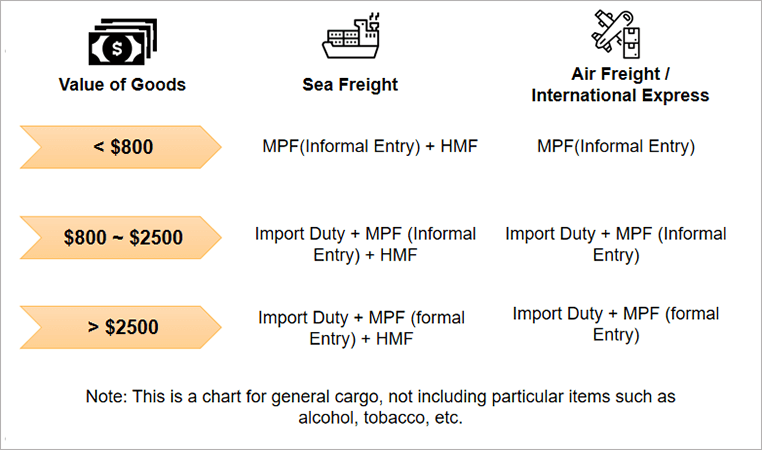
What Is the Additional Customs Duty Rate from China to the USA?
Since Trump raised tariffs on Chinese imports, as importers, you may have lots of questions struggling in your mind: Is your product hit with the additional 25% tariff? Can you still afford to import from China to the USA? Whether you should continue sourcing from China or buying locally or elsewhere? Though the U.S. is considering reducing tariffs on some Chinese goods now, these questions may still bother you.
Additional Tariff List 1&2
Up to now, the additional 25% tariff lists on the product of China have gone through 3 different stages. The first two lists impose an additional 25% tariff on approximately $50 billion Chinese imports and mainly target products central to Made in China 2025 initiative.
Products such as technological parts, electronics, and machinery used to make or process textiles, food, etc will be hit with the 25% tariff as a result. The importer can search for HTS 9903.88.01 or 9903.88.02 for a special tariff rate for the product of China.
Additional Tariff List 3
The 3rd list collects another 25% tariffs on $200 billion imported Chinese goods. It covers categories such as consumer products, chemical and construction materials, textiles, tools, food and agricultural products, commercial electronic equipment and vehicle/automotive parts, etc. You can find the finalized List 3 here. The importer can search for HTS 9903.88.03 or 9903.88.04 for a special tariff rate for the product of China.

Additional Tariff List 4
The 4th list proposed to subject 25% duties on another $300 billion China imports. It would cover essentially all the remaining US imports from China, including the following categories:
- Agricultural and food products, including meat, dairy, produce, and alcohol;
- Industrial chemicals, minerals, and other raw materials;
- Live animals including livestock, insects, and birds;
- Steel and aluminum products currently excluded from List 1 duties during the comment period but subject to additional duties under Section 232;
- Other base metals;
- Textiles and apparel, including footwear;
- Household goods;
- Jewelry, gemstones, and precious metals;
- Machinery, computers, televisions, and other electronics;
- Vehicles including motorcycles, watercraft, and aircraft;
- Numerous categories of scrap and waste materials;
- Firearms, ammunition, and other weapons;
- Recreational equipment;
- Personal hygiene and grooming items;
- Books and artwork.
Source: Office of Federal Register. You can find the proposed products here.
But actually, it imposed another 15% tariff on $112 billion Chinese imports. After the United States and China signed a “phase one” agreement, List 4A additional tariffs were decreased to 7.5%, while List 4B was suspended.
Tariff Calculation Step 1: Check HS Code of Your Products
What Are HS Code & HTS Code?
Before checking the rate, there is some basic knowledge you should know about the HS code ( The Harmonized System) and HTS code (Harmonized Tariff Schedule)
HS code is administered by the World Customs Organization. It’s a standardized international method of classifying globally traded products. Each HS code represents one product category. The first 6 digits of the HS code are the same in all countries. And each country can modify its own HS code by adding another two or four digits without changing the first 6 digits.
HS code can be divided into four parts: chapter, heading, sub-heading, and extra digits. Take HS code 0102.21.0010 for example.
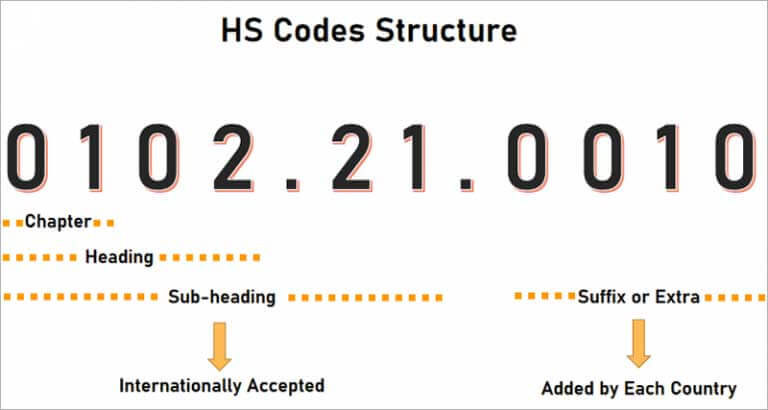
Chapter 01 means live animals. Heading 0102 is live bovine animals. It dictates the specific category under chapter 01. Sub-heading 0102.21 means purebred breeding animals, a more specific subcategory under heading 0102. These six digits, 0102. 21, are the same in the HS code of each country. The last four suffix or extra digits, 0010, can be added by each country itself as a further classification of sub-heading. Here, 0010 means male.
Thus, together, HS code 0102.21.0010 is meant for Male Purebred Breeding Animals under heading 0102 (Live bovine animals), under chapter 01 (Live Animals).
HTS code is a US import classification system. Based on the HS code, the HTS code expands its scope to 10 digits. It determines the applicable tariff rate of all merchandise imported from different original countries into the states.
How to Check HS Code.
If you only have your product name and want to know its HS code, here are three simple ways for you to get the code.
1. HS code lookup tool. You can have a quick online HS code search via the HS code lookup tool by typing in product keywords (eg. shoes) and selecting the category related to your product. In this way, you’ll get the first 6 digits HS code.

2. Search on USITC. Type in the product keyword (eg. shoes) directly on the search page of USITC and you’ll find there are different codes to choose from. You need to look through the description to find one that applies to your products. The product HS code corresponding to the description is what you need. And you can get the relevant duty rate at the same time.
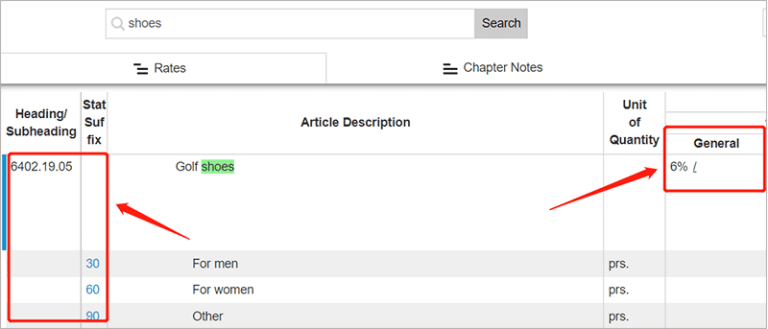
3. Check with a customs broker or freight forwarder. They can help you do customs clearance successfully, including randomized examinations. When you find it difficult to identify the exact HS code for your product during the above search, it is advisable to check with your customs broker or international freight forwarder to get the specific HS code.
Tariff Calculation Step 2: Check Import Duty Rate Online.
The HTS classification can be very complicated. If you self-classify an item and the classification is incorrect, the mistake can be costly.
Please also note that you can get an approximate idea of the duty rate of a particular product through your own search. The U.S Customs and Border Protection makes the final determination of what the correct rate of duty is.
Here are the most convenient ways to help you check the rate online.
1. Find the latest duty rate information on the U.S International Trade Commission website (USITC) for HTS Revision by chapter, then scroll down to the section that your product falls under and click on the chapter that relates to your product.
2. Type in the H.S code you get (eg. 6403.19.1000) on the search page of USITC to check the rate (eg. 5%).

3. Contact a customs broker or CBP specialist for very specific duty information on a particular product by calling your local CBP port.
Tariff Calculation Step 3: Check If Your Product Is Hit with Additional Duty Rate.
After the first two steps, you’ve already known how to check the rate on USITC. Now we’ll show you how to find whether your product is charged with another 25% rate under the trade war.
For example, HS code 8408.10.00 is meant for Marine propulsion engines. Before the trade war, the general duty rate was 2.5%. However, as you can see below, there is a “/” followed, asking you to refer to sub-heading 9903.88.01. When you search 9903.88.01, you’ll see plus 25%.
It means that, for products of China, the current rate is the duty rate provided in the applicable subheading (2.5%) plus 25%, which comes to 27.5%, the new tariff rate.
The General Duty Rate

Plus Additional Tariff

In the article description, note 20(a) and note 20(b) are mentioned to help you get a better understanding. You can find a detailed explanation under Chapter Notes as shown below:
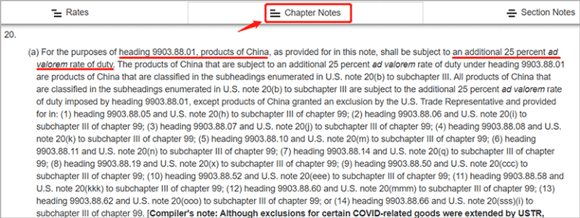
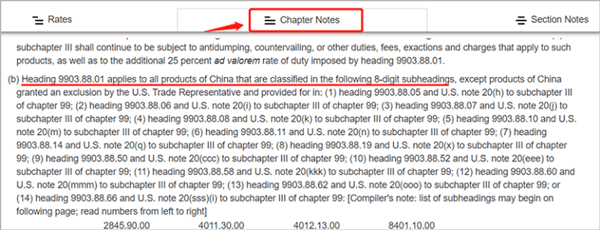
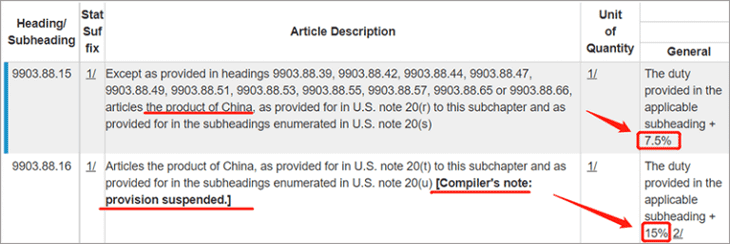
Tariff Calculation Step 4: Calculate How Much Customs Duties & Tax You Need to Pay.
After getting the current duty rates, it’s time to calculate the import duty and total import tax which mainly consists of the following parts:
- Customs Duty: customs value * customs duty rate / imported quantity * customs duty rate
- MPF Fee: commercial value * 0.3464% (not less than $27.2 and more than $528.33)
- HMF Fee: commercial value * 0.125%
Calculation Example One:
You are importing Blankets into the US by ocean freight. The total commercial value is $3,000.
The customs value is based on the declared value of goods. It’s the total value of all your products in the shipment. You can find it on the commercial invoice. And it’s $3,000 here.
For the customs duty rate, let’s say you get the HS code from the supplier: 6301.30.0020. Search it on USITC and you’ll find the current rate is 15.9% (8.4%+7.5%), as shown below.
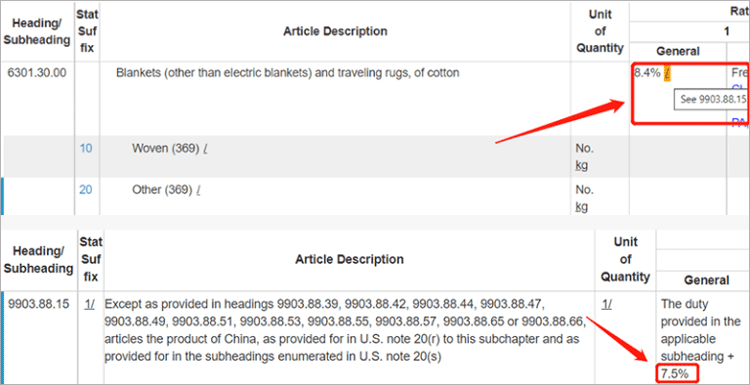
After knowing the value of the goods and rates of duty, we can do the calculation as below:
- Customs Duty: customs value ($3000) * rate of duty (15.9%) = $477
- MPF fee: commercial value ($3000) * 0.3464% = $10.392 (less than $27.2)
- HMF fee: commercial value ($3000) * 0.125% = $3.75
- Total Import Tax: $477 + $27.2 + $3.75 = $507.95
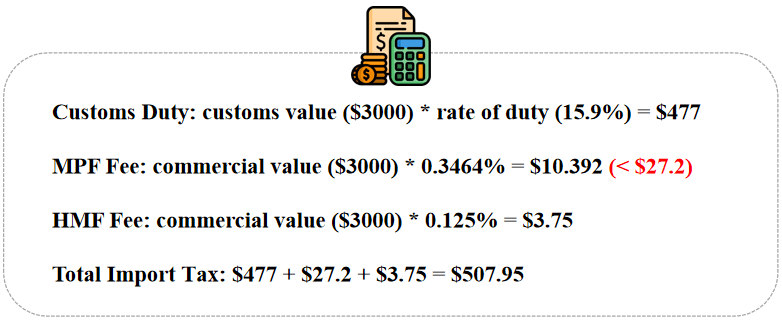
Calculation Example Two:
You are importing 10,000 liters of non-alcohol beer into the US by ocean freight, with a total commercial value of $8,000.
Type in HS code, 2202.91.0000 on USITC and you’ll see a specific duty rate, 0.2¢ per liter, with an additional 7.5% tariff, as shown below.
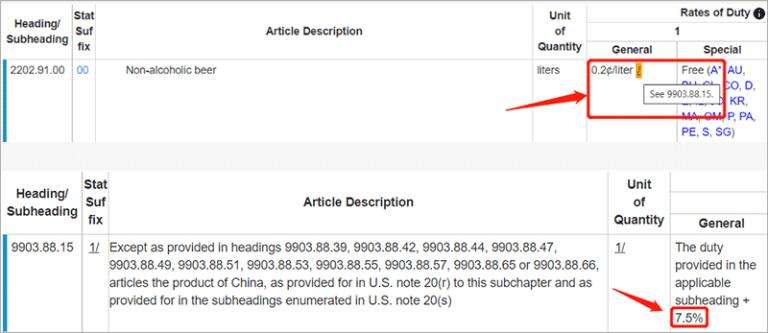
When the duty rate is specific, like XX¢ per liter/kilogram, you should multiply the imported quantity by the duty rate to get the general duty fee. Now let’s do the calculation:
- General Customs Duty: quantities (10,000 liters) * rate of duty (0.2¢ per liter) = 2000¢ or $20
- Additional Customs Duty: customs value ($8000) * rate of duty (7.5%) = $600
- MPF fee: commercial value ($8,000) * 0.3464% = $27.712 > $27.2
- HMF fee: commercial value ($8,000) * 0.125% = $10
- Total import tax: $20 + $600 + $27.712 + $10 = $657,712
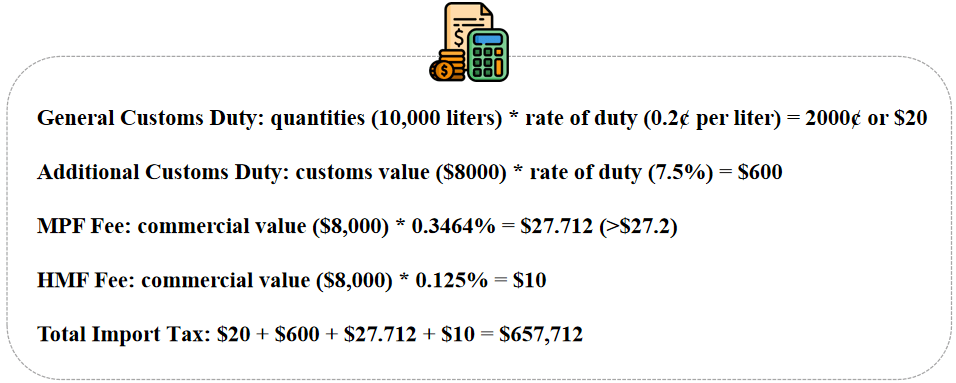
Remember that it is the CBP who finally determines the correct duty rate. The actual rate of the item you import may not be what you think it should be. But the above search method and calculation can give you a rough idea of how much the import tax is to help you calculate the import costs per item even before you import.
How to Pay the Import Tax?
How to pay tariff is related to shipping methods. When your goods are valued at $800 or more and shipped by international express, it will be convenient for you to pay the import tax, because the express agent will pay it for you in advance, and you just need to pay the courier later.
Here is another situation that you don’t need to worry about tariffs. That is when the quote you get from the supplier is DDP price (Delivered Duty Paid). Your supplier will be responsible for import clearance and pay for all the import duties and taxes.
However, if your goods are shipped by air or ocean freight, and not shipped to your door, the import clearance process is complex. Under these circumstances, you’d better buy the service of local customs brokers. They’ll help you prepare all the documents needed to declare the goods upon their arrival.
One very important document during the import entry process is the entry form (CBP Form7501). It goes with the calculated import tax from China to the USA. You can find an example form below:
Example (CBP Form7501)
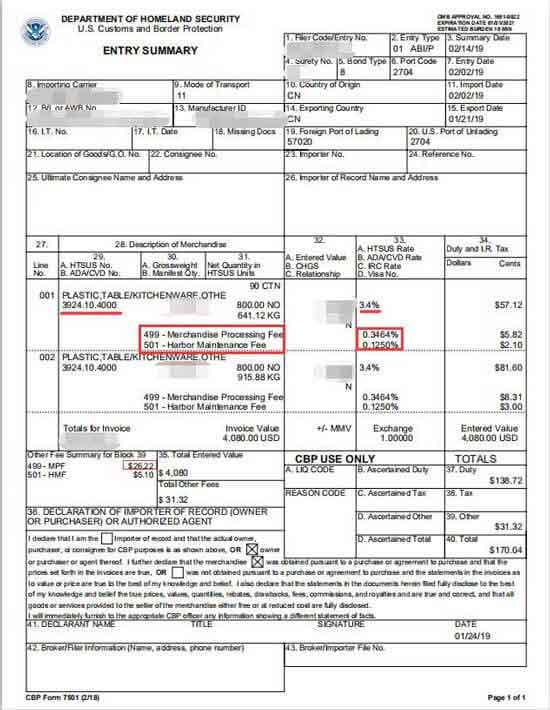
When Is a Customs Bond Required?
According to CBP requirements, importers must post a customs bond if they are importing merchandise valued over $2,500 into the USA for commercial purposes, or a commodity subject to other federal agencies requirements (i.e. firearms or food).
What Is a Customs Bond?
A customs bond sometimes is also called a US surety bond. It assures CBP that the importer will fulfill any financial responsibilities for customs duties, penalties, and other obligations. The surety company pays CBP first and CPB releases your goods. As an importer, you just need to give the money back to the company later
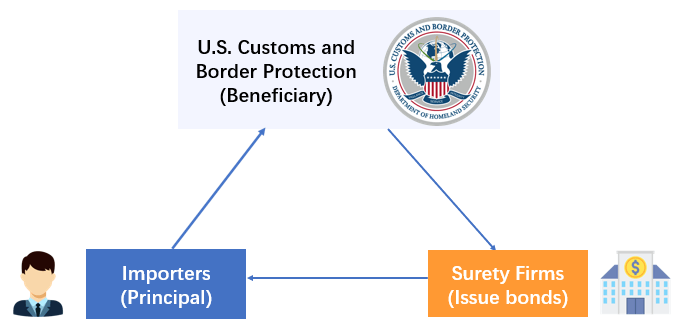
How to Get a Customs Bond?
The easiest way for importers to obtain a customs bond is through a customs broker or an international freight forwarder.
When you import goods subject to FDA’s requirements and regulations, you need to register your importer information on the FDA website. In such a situation, US customs won’t accept the forwarder’s identity for the imports. Thus, you’d better purchase a customs bond from a customs broker to prove that you have the qualification to import those goods.
If you want to clear the goods under the name of your own company, you must purchase a customs bond through a surety agency licensed by the U.S Treasury Department. If you use the customs broker to clear your goods through CBP, then the broker’s bond can be used. For a list of licensed customs brokers, check at the port of entry.
What Are the Common Ways to Avoid Or Reduce the Import Tax?
a.Common Situations Not to Pay for Duties
There are several situations when there is no need to pay the import tax. They are:
(1) Personal exemption. According to CBP, there is a duty-free exemption, or personal exemption, which is the total value of goods you can bring back to the United States without having to pay duty. In most cases, the personal exemption per day is $800, but there are limits on the number of alcoholic beverages, cigarettes, cigars, and other tobacco products.
(2) Samples. Samples are another exception, as your samples are for your own evaluation and will not be resold for commercial purposes, you can ask your supplier to put the samples at a nominal value of $1 and mention on the Sample invoice “Sample of No Commercial Value”.
(3) Dropshipping. In the dropshipping business, as the goods are delivered directly from the third party (manufacturer or wholesaler) to the customer via ePacket or China Postal Parcel, no import duty is charged; however, the seller will have to pay income tax and sales tax.
b.Common Ways to Reduce Import Duty (Attention!)
Although some people tend to use the below methods to reduce import tax, considering the risks involved, we’ll not suggest you do like them.
(1) Lowering product value on the commercial invoice. Given a certain rate, based on the formula of calculating customs duty, one possible way to reduce the import duty is to lower the declared value. As agreed with the importer, some suppliers will help put a lower product value to help the buyer reduce the customs duty.
However, if the U.S customs find that the declared value is less than the actual value and is lowered on purpose, the customs will impose a punitive tariff, even worse, the goods might also be destroyed or returned to the port of loading.
(2) Separating the delivery into several batches by international mail. Imports of goods valued at more than $2,500 will require a formal entry. For some importers, they’ll ask the supplier to send through the international postal system and separate the delivery into several batches, with each less than $800.
However, be cautious and think twice before you actually do this. The personal exemption may only be applied to goods accompanying travelers. If the U.S customs find your behavior is deliberately taken to reduce tax, the exemption will not be permitted. In addition, the total shipping cost by express can also be high.
(3) Through intermediate trade or entrepot trade. Under the pressure of the additional 25% tariff policy targeting imports from China, some people are considering transit goods at a third country, then exporting to the USA using the third country as the country of origin, instead of China, to avoid the increasing import duties. However, there are still many risks involved in the process, and will also occur high transition costs.
What Import Duty Calculators Can Help You Simplify the Calculation?
Considering the complicated product classification, finding the accurate HTS code and estimating the tariff fee may not be as simple as you think. There is another easy way to calculate the import tax, using an import duty calculator for an automatic calculation.
I collect some customs duty calculators. You can go to their website, fill in the relevant information under the guidance and get the final calculation results directly if you don’t have time to calculate customs duties step by step by yourself. But it’s only estimated customs duties, not including MPF and HMF fees.
Freightos
We have mentioned that you can use Freightos to search HS codes, also it’s a free import duty calculator. Just type in the importing country, exporting country, enter the product description or HS codes, and shipment value in USD, you’ll get the estimated duties.

Simply Duty
It’s a quick tool to help you calculate import duties from China to the USA. Type in the destination country, country of origin, production description, HS codes, and product value, you’ll get duty & tax charges. If you also type in shipping cost and insurance cost, it will help you calculate the total landed cost. But pay attention, it doesn’t cover the additional tariffs.
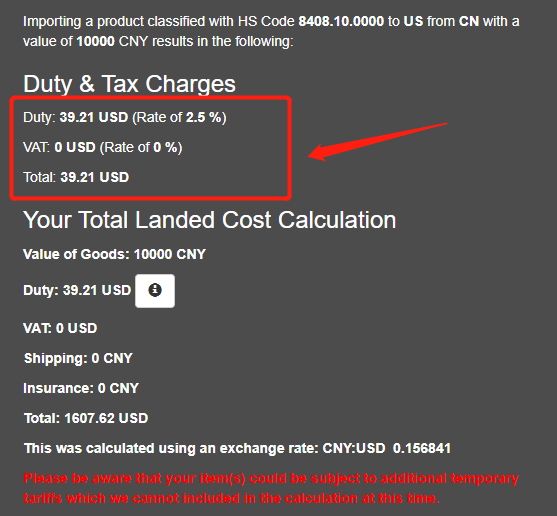
Avalara
Product classification is essential in customs duty calculation. You may pay less or more taxes than you actually should pay because of the incorrect classification. Avalara provides HS codes automatically so that you can assess customs duties and taxes more accurately. But it can’t help you calculate duties directly like Freightos and Simply Duty.
Goodada
If you want to use Goodada to calculate import duties from China to the USA, you should fill in the information needed, as shown below, and wait for a customs broker to contact you.
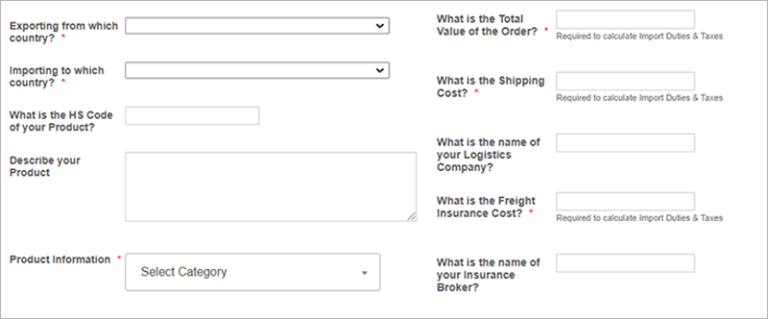
Q&As about Import Duties from China to the USA.
1. Do I Have to Pay Import Duty from China to the US?
It depends on the different situations. Only when the value of goods is at $800 or more, you have to pay the import duties. Less than $800 is duty-free. Please note that $800 here doesn’t cover freight and insurance.
2. Who Pays Customs Duties? Sender or Receiver?
The United States imposed customs duties on imported goods. A registered importer should pay the duties. That is to say, the receiver of the goods is responsible for the duties.
3. How Much Is Customs Duty from China to the US?
It requires calculation. According to different tax rate forms, there are two calculation formulas: customs value * customs duty rate or imported quantity * customs duty rate. And most of the time, you need to add an additional duty rate, maybe 25% or 7.5%. To estimate the tariff fee, you can refer to the step-by-step guide above.

Your article was excellent. If I can indulge your help. I am planning on shipping container homes into Los Angeles port and trying to quantify costs. Two Units fit into one 40’HQ. Each Unit is $7500 USD making the combined cost is $15,000. The ocean freight is $13,000. The HTS Code is: 9406.90.0030. Do I pay the 2.9% + 25% US tariff on the freight as well? or just the $15,000 for the product?
Hi Bill,
You have got the HTS code of container homes, you could visit this site and call them directly for accurate information about the import tariff:https://www.usitc.gov/harmonized_tariff_information. Because tariffs and policies of the USA change in real time, I can’t give you a definitive answer as to whether your products will be subject to an additional 25% tariff.
I have no idea what I’ll have to pay for customs and duties. I have an online business that I’m just starting, for now the business will be under my name. I’m planning to buy one China wholesale order for $180 and a separate one for $285. Will I be charged customs and duties if I have it shipped via UPS Saver shipping? Anyone experienced know exactly what they’ll charge me? Thanks for the help, I haven’t done this before so I really don’t know. I read that they won’t charge me anything since the price is so low and… Read more »
Hi Mel,
Sorry for the late reply, there is no tariff for goods with a declared value of less than US$800 to the United States, and it also doesn’t matter who owns the business.
Oh, my gosh! I ordered a food trailer that was made in China. It left Shanghai port on the 30th and is expected to arrive in Los Angeles on June 12, 2021. Not looking forward to the import tax I will have to pay on $9,450. :-((
Hi O.F.Lucas,
$9,450 for shipping a food trailer? What’s its size?
Hello Xindan Li,
The cost of the food trailer was $9,450 and the shipping cost was $3,800. Someone told me that I would most likely have to pay taxes on the $9,450.
The dimensions of the food trailer are, 3.0 x 2.0 x 2.4 M (9 feet 8 inches x 6 feet 5 inches x 7 feet 8 inches).
Hey friend,
Don’t listen to “someone”. You should check the customs website of your country. And consult with the forwarder in your country for the exact information. I am not clear about your products and customs rules, so I am sorry that I cannot give you practical suggestions.
Thank you, Xindan Li.
I contacted a customs clearance broker in California. He will be handling the shipment, forms, paperwork, etc. He already filed my ISF form and told me not to worry. He said he will be in touch with me when the trailer arrives at the Los Angeles port from Shanghai.
Yes, you need someone who is professional to help you with things like that, which makes you convenient and at ease. Sorry again for my late reply.
No problem, Xindan Li.
And thank you for the advice!
Hi Xindan. Great article, thank you. I’m new to this so I would like to ask you if this $800 criteria considers the product cost + shipping costs (landed value). Or only the product acquisition costs?
Thank you in advance.
Best,
Sara
Hi Sara,
The “$800” only refers to the value of the goods, not including shipping cost.
Hello Sir, I have a couple questions I would love to ask you in respect to importing from China. I am a wholesaler looking to purchase products from China. Can you please contact me at my email to ask a few questions? Or how do I contact you? This is a excellent writeup that has helped tremendously. My very first shipment from china was hit with a $650 tariff which made my eyeballs pop out of my head :) Thanks!
Yes, any question, you can send us an email: [email protected]
Great article! I understood so much of what I didnt know before. One question. If shipping via air, no travelers, goods value under $800, there will be no taxes correct?
I see my 9401.7900 is my hts code – in column 1 it says no tax – could this be correct – column 2 is 45%. What is column 2? Its dinning tables and chairs. valued for both $3000 usd
Hi, does this apply to air express shipping (FedEX, DHL or UPS)? Do I need to pay import duties if my total commercial invoice value is more than $800 or $2500? Does air express shipping require an HS code for total commercial invoice value more than $800 or $2500? Thank you.
Thanks for your inquiry. Express shipping also needs tax paid and needs HS code if your commercial invoice value more than $800. Our customer service will send an email to discuss more and can help calculate costs with you
hello, congratulations on the content. very good!
I am Brazilian and I live in Brazil, seeing in the united state amazon.
I would like to import from china and send it straight home to my family who lives in the USA, all are Brazilian too.
Can I do all import process on my behalf, even if I’m not an American person and not living in the USA?
I would like a contact for a possible consulting.
thank you!
Hi Carlos, you can do all the import process in your name as long as you know how to do those procedures. Even if you don’t to how to do, you can ask a freight forwarder to help you.
Hi Jing,
Thank you for the very helpful article.
Follow up question for you please:
In the article you mentioned that “The personal exemption may only be applied to goods accompanying travelers.”.
Does the $800 de minimis exemption apply only to goods accompanying travelers?
If the total value of my goods is less than $800 and I send it from China to the USA by Express Courier, will I be required to pay customs tariffs?
Thanks Jing.
Hi Michael, US Customs imposes tariffs on all imported goods valued at $800 or more. Values below $800 are tax-free.
So anything under $800 doesn’t get charged anything except for what they wholesaler charged? If I order goods from China, one shipment for $180 and another for $290 for pet supplies, will I be charged anything extra besides what I paid the wholesaler? Since the price is low and the business is under my name, I assume I won’t be charged anything extra, my shipment won’t be held up, and it’ll be shipped to my door as usual?
YES, Mel, there is no tariff for goods with a declared value of less than US$800 to the United States, and your goods will be shipped to your door as usual.